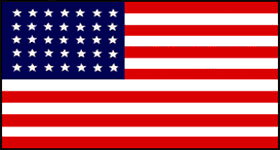 |
Civil War Battles |
|
State War Records |
| AL - AK - AZ - AR - CA - CO - CT - DE - FL - GA - HI - ID - IL - IN - IA - KS - KY - LA - MA - MD - ME - MI - MN - MS - MO - MT - NE - NV - NH - NJ - NM - NY - NC - ND - OH - OK - OR - PA - RI - SC - SD - TN - TX - UT - VT - VA - WA - WV - WI - WY |
The Battle of Birch Coulee
September 2, 1862 in Birch Coulee, Minnesota
 |
|||||||||||||||||||||
|
Birch Coulee was the river from the abandoned buildings at the Lower Agency. It ascended inland from the river's bottomland. Its heavily wooded draw rose to the prairie close to where the Union army made camp. There had been threats of Indians in the area for a while. There had been many Indian attacks against the settlers and Union troops along this part for a few months. Even though the Federals had been told that there wasn't any local Indian threat around, they still took precautions at the camp by setting up defensives measures. The wagons were formed up in a semi-circle with ropes tied between them. Few tents were set up and pickets were stationed not far from the camp. The army was led by Capt. Hiram P. Grant Maj. Joseph R. Brown.
Chief Little Crow and Chief Gray Bird led the Dakota Indians toward the Union army's camp. They arrived on the afternoon of September 1 and camped for the night. Their plan was to surround the Union camp during the night and attack them at daybreak the next morning. During the night, the Indians crossed the river, divided into seperate parties, and worked their way to the Union camp
On September 2, around 4:00 A.M., a Union picket fired a shot at what he thought was a wild animal. It was the Indian parties. They instantly rose from their concealed positions and charged the pickets back to their wagons. Once there, the Indians unleashed a deadly volley into the Union camp. The stunned Union soldiers were waking up to find themselves under attack. After an hour of close attacks, the Indian parties pulled back and a long range assault began. Almost half of the Union soldiers were killed or wounded and 85 out of 87 horses had been killed.
The Federals began digging rifle pits and breastworks with whatever they had. They also continued to keep the Indians at a distance. At nearby Fort Ridgely, news of the attack arrived. Reinforcements of about 240 soldiers, led by Col. Samuel McPhail, were sent to the beseiged Union camp. The reinforcements were attacked just before they reached the camp. They managed to hold off the Indians for awhile and fell back to a defensive position. McPhail sent word to Fort Ridgely to send more men to help himself out.
On September 3, the reinforcements left at sunrise. They arrived and helped to fend off the remaining Indians. by 11:00 A.M., the rest of the attacking Indians had left the area.
Books on The Battle of Birch Coulee available From Amazon.com
